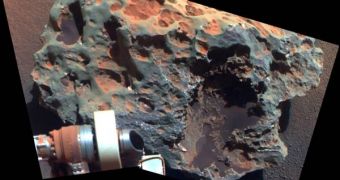In its trek on the surface of Mars, the rover Opportunity has recently come across an ancient meteor, made almost entirely out of metal, according to investigators at the Jet Propulsion Laboratory (JPL), in Pasadena, California. The peculiar formation is currently helping planetary scientists gain a deeper insight into the ancient environmental history of the planet, and Opportunity has taken a break from its long journey so that it can analyze it further.
Opportunity's new object of interest, called Block Island, is among the largest meteorites thus far discovered on the Red Planet. Analyzing it poses some questions about the atmosphere, researchers say. They argue that a meteorite this size couldn't have entered it intact, and that it most likely broke off in several pieces. Unless, of course, the atmosphere was a lot thicker when it landed than it is estimated to be today. Additionally, experts hope to probe the rock for more details on how the climate has affected the rock over the years.
By the time pictures of the rock reached the Earth, some two weeks ago, the rover had already driven more than 600 feet passed it. Mission controllers were so puzzled by the appearance that they had the robot backtrack, and commanded it to start investigations. The probe even touched the meteorite with its robotic arm, so as to get a closer “feel” of its composition.
“There's no question that it is an iron-nickel meteorite. We already investigated several spots that showed elemental variations on the surface. This might tell us if and how the metal was altered since it landed on Mars,” explains Ralf Gellert, from the University of Guelph in Ontario, Canada. He is the lead scientist in charge of operating the alpha particle X-ray spectrometer instrument on Opportunity's robotic arm, which is used whenever a foreign object is discovered and needs to be looked at.
Block Island even exhibits a triangular pattern, which scientists found as resembling those on iron-nickel meteorites back on Earth. “Normally this pattern is exposed when the meteorite is cut, polished and etched with acid. Sometimes it shows up on the surface of meteorites that have been eroded by windblown sand in deserts, and that appears to be what we see with Block Island,” says Smithsonian Institution in Washington expert Tim McCoy, who is also a member of the rover team.
“Consideration of existing model results indicates a meteorite this size requires a thicker atmosphere. Either Mars has hidden reserves of carbon-dioxide ice that can supply large amounts of carbon-dioxide gas into the atmosphere during warm periods of more recent climate cycles, or Block Island fell billions of years ago,” says JPL scientist and rover team member Matt Golombek, quoted by ScienceDaily.

 14 DAY TRIAL //
14 DAY TRIAL //